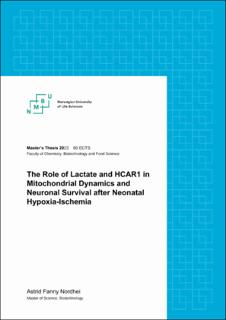| dc.description.abstract | Neonatal Hypoxia-Ischemia (HI) is one of the most common causes for death and disabilities in infants. It is responsible for 23% of infant mortality and it affects 0.7-1.2 million neonates annually. Today the only treatment currently available is hypothermia. However, this treatment does not prevent all brain injury and many patients surviving HI develop neurological disorders such as seizures, hearing and vision loss in later years. Hence, further research is needed to develop new and effective treatments to reduce post-ischemic injury and to improve brain tissue regeneration. Recent research from mouse models on HI has shown that the administration of lactate has a positive effect on recovery. In a paper published by our group it was discovered that the lactate receptor hydroxycarboxylic acid receptor 1 (HCAR1) plays and important role for cell proliferation and brain tissue repair after HI. This study has revealed that HCAR1 does not only play a role in cell proliferation after HI, but that it could also play a role in the survival of mature neurons. By immunostaining on brain sections from mice exposed to HI, we found that the density of neurons was significantly lower in mice that lacked the HCAR1 receptor. Since mitochondrial metabolism is closely linked to neuronal survival and apoptosis, we then used differentiated neurospheres to test the effect of lactate on mitochondrial density in neurons. However, our experiments did not show any effect of lactate on the density or number of neuronal mitochondria. Finally, we used western blotting to determine whether HCAR1 can influence the expression of mitochondrial proteins after HI. Our data suggested that mice lacking HCAR1 have a reduced expression of a mitochondrial protein involved in respiration, but more data points are needed to confirm this finding. Hence, it is also possible that HCAR1 could be involved in other metabolic processes such as regulating the cell’s energy metabolism and protein expression. Further research of HCAR1 in mouse models and in human tissue is important as this receptor as it is a therapeutic target for treatments against HI and possibly stroke in elderly people. | |
